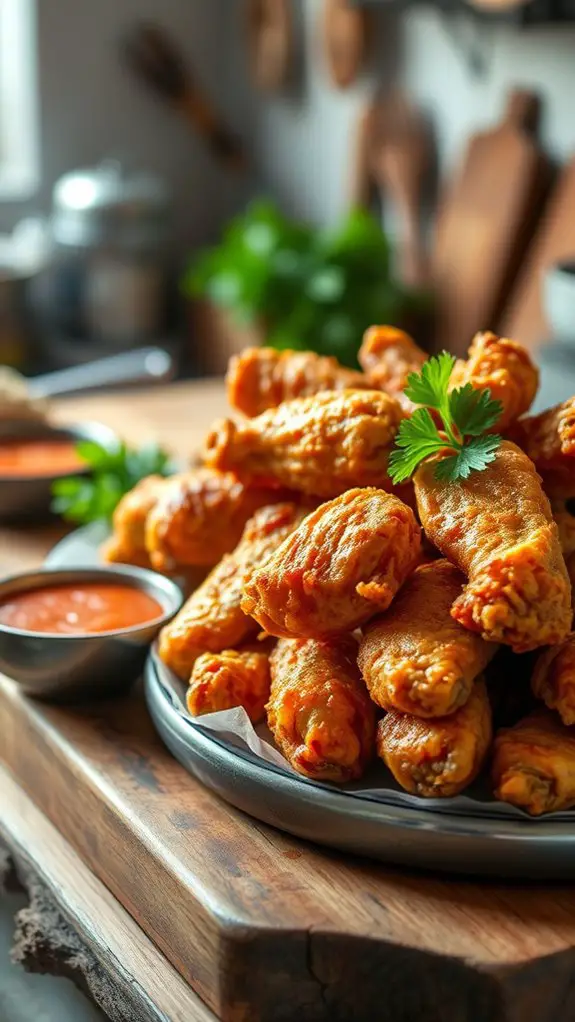You're at your buddy's place, catching the big game on TV. Suddenly, a platter of deep-fried chicken wings appears, glistening and sizzling. The aroma is mouthwatering, and you can't help but reach for one. As you bite into the crispy skin and juicy meat, you're transported to a world of savory satisfaction. But beyond the indulgence, there's more to explore about this beloved snack.
History

Although the exact origins of deep-fried chicken wings are unclear, historians believe the dish emerged in the mid-20th century as a popular snack food and appetizer.
Over time, chicken wings have gained cultural significance, becoming a staple at sporting events, parties, and casual gatherings.
Regional variations have also emerged, with some areas developing unique seasoning blends or cooking techniques that give the wings their distinct flavors.
Whether dripping in spicy sauce or simply salted, deep-fried chicken wings have become a beloved comfort food enjoyed by people around the world.
Recipe

Deep-fried chicken wings are a classic indulgence, offering a delightfully crispy exterior and juicy, flavorful interior. This recipe will guide you through the steps to achieve the perfect deep-fried chicken wings in your own kitchen.
Preparing the wings properly is the key to success. It's vital to verify the wings are thoroughly dried and seasoned before frying to achieve that coveted crunch. The type of oil used and the temperature maintained during the frying process also play an important role in the final outcome.
Ingredients:
- 2 lbs chicken wings, drumettes and flats separated
- 1 cup all-purpose flour
- 1 tsp paprika
- 1 tsp garlic powder
- 1 tsp onion powder
- 1 tsp salt
- 1/2 tsp black pepper
- Vegetable or peanut oil for frying
Instructions:
Pat the chicken wings dry with paper towels. In a large bowl, combine the flour, paprika, garlic powder, onion powder, salt, and black pepper. Add the wings and toss to coat evenly.
Heat 2-3 inches of oil in a heavy-bottomed pot or Dutch oven to 350°F. Working in batches, carefully add the coated wings to the hot oil and fry for 12-15 minutes, turning occasionally, until golden brown and crispy. Drain the wings on a paper towel-lined plate.
When frying the wings, it's crucial to maintain the oil temperature to guarantee even cooking and prevent the wings from absorbing too much oil. Additionally, letting the wings rest on a paper towel-lined plate after frying will help remove any excess oil, resulting in a crispy and delectable final dish.
Serve the deep-fried chicken wings immediately, and enjoy their irresistible crunch and flavor.
Nutritional Guide
While deep-fried chicken wings may satisfy the craving for a crispy, flavorful indulgence, it's important to evaluate their nutritional profile.
One serving of deep-fried chicken wings contains a substantial caloric content, often reaching over 400 calories. Additionally, they're a significant source of protein, providing around 30 grams per serving.
However, the high fat and sodium content can potentially outweigh the benefits of the protein. Moderation is key when enjoying deep-fried chicken wings, as their indulgent nature can contribute to weight gain and other health concerns if consumed excessively.
Understanding the nutritional facts can help you make informed decisions about incorporating this dish into a balanced diet.
Final Thought
Ultimately, you must weigh the tradeoffs between the indulgence and potential health risks when considering deep-fried chicken wings.
While the crispy, golden exterior and savory flavors can be immensely satisfying, the cooking techniques involved introduce elevated levels of fat and calories.
However, thoughtful preparation and strategic flavor combinations can mitigate some of these concerns. Pairing the wings with fresh, crunchy vegetables or incorporating zesty marinades may enhance the overall experience while balancing the heavier elements.
Ultimately, deep-fried chicken wings can be enjoyed in moderation as part of a well-rounded diet, acknowledging both the pleasures and potential drawbacks of this classic comfort food.